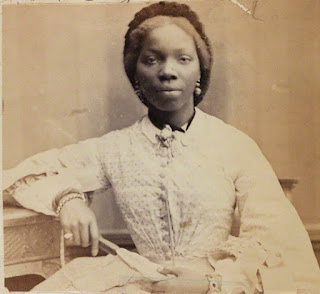Sara Forbes Bonetta
Sara Forbes Bonetta, (born Omoba Aina; 1843
– 1880), was an Egbado princess of the Yoruba people in
West Africa who was orphaned by war and later became the slave of
King Ghezo of
Dahomey. She was rescued from slavery by Captain Frederick E. Forbes of
the British Royal Navy and became a goddaughter to Queen Victoria.
Originally named Omoba Aina, she was born in 1843 at Oke-Odan,
an Egbado village.
In 1848, Oke-Odan was raided by a Dahomeyan army;
Aina's parents died during the attack and at the age of five she ended up as a
slave at the court of King Ghezo. It is believed that her captors intended to use her as
a human sacrifice (though I’m always a little wary of such tales coming from
colonial sources #barbiansandthatinnit). Anyway, she was discovered by Captain
Frederick E. Forbes of the Royal Navy,
who arrived to Dahomey on a British diplomatic mission to negotiate the
end of Dahomey's participation in the Atlantic slave trade. Although Dahomey refused
to end its slave trade, Forbes convinced King Ghezo to “gift” Aina to Queen
Victoria. Forbes renamed her Sara Forbes
Bonetta, after his ship HMS Bonetta. While
the idea of her being “Given” as a gift to a colonial power sits very
uncomfortably with me, this would prove to be a fortunate event in her life.
In 1850, Sara was introduced to the queen, who called her “Sally”. The Queen was impressed by the young princess’ “exceptional intelligence” and arranged for her to be raised as her goddaughter. She clearly harboured genuine affection for the young girl, and recognised her worth, as she paid for her education in Sierra Leone and Kent.
In 1851, Sara developed a chronic cough, which was attributed to the
climate of Great Britain. Her guardians sent her to school in Africa in May,
aged eight, and she returned to England in 1855, aged 12. She was entrusted to
the care of Rev Frederick Scheon and his wife. In January 1862, she was invited
to and attended the wedding of Queen Victoria's daughter Princess Alice, showing
her high status in Victorian society and amongst the Royal Family itself.
Bonetta later lived in Brighton, where she met a wealthy Sierra
Leone-born merchant, James Davies, whose own parents were liberated slaves. In
1862, she sought the Queen’s permission to marry Captain James Pinson Labulo
Davies at St Nicholas' Church, Brighton. The wedding
drew national and international attention and saw people lining the streets to
glimpse the couple and the visiting dignitaries. Captain Davies was a Yoruba businessman
of considerable wealth, and after their wedding the couple moved back to their
native Africa, where they had three children: Victoria Davies (1863), Arthur
Davies (1871), and Stella Davies (1873).
Sara Forbes Bonetta continued to enjoy a close relationship with Queen
Victoria to the point such that she was one of only two Lagos indigènes whom
the Royal Navy were ordered to evacuated during any trouble in Lagos. Her first
daughter, named after the Queen, was also adopted as a goddaughter by her
namesake. Many of Sara's descendants now
live in either England or Sierra Leone,
while a separate branch, the aristocratic Randle family of Lagos,
remains prominent in contemporary Nigeria.
Sara died of tuberculosis on 15 August 1880 in the city of Funchal, Madeira. Her husband, Captain Davies, erected a granite obelisk-shaped monument more than eight feet high in memory his wife in Western Lagos, where he had started a cocoa farm.
The historian David Olusoga has described Bonetta as a
symbol in that “she became biographic shorthand for the perceived
accomplishments of Britain’s civilising mission”. Others have hailed Sara for “challenging
our assumptions about the status of black women in Victorian Britain”. Others,
however, highlight that Bonetta also betrays the ‘more uncomfortable sides of
colonialism, such as how she was “viewed as a specimen of what a negro woman
could become with the right patronage”’.
I had never heard of Sara apart from a small cameo in the TV
Series, Victoria. However, I saw an article on her relating to Black History
Month and was fascinated to read more about her story. Queen Victoria’s complex
relationship with her colonial subjects is one of my favourite topics to study
(as discussed in my previous post on her relationship with her Munshi, Abdul
Karim). However, Sara’s story is one which shows that black people were not
always unwelcome outcastes in British society – rather they wined and dined
with the most elite and powerful families in the land, and while her tragic
death took her too soon, she came a long way from her childhood slavery. That
her education is mentioned frequently in contemporary sources also makes me
really happy – not only does it celebrate women for their mind instead of their
beauty and marital status (a rarity now let alone in the Victorian era), it
also debunks the idea of racial inferiority which reached it’s peak in the
nineteenth century, and also challenges the stereotypes of the history of black
people to British history.








Comments
Post a Comment